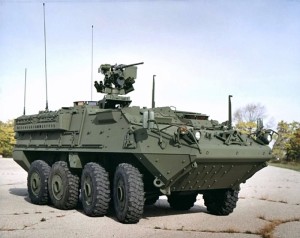Army developing more lethal ‘top gun’
In one corner of the Army, the story of a drive to improve the kill power of a proven platform.

When I saw the giant, olive-drab colored vehicle parked opposite the Federal News Radio booth, I wondered, is that the front or the back? Then I spotted the headlights mounted in little pods, looking like eyeballs on a reptile. That must be the front. The Stryker combat vehicle presents a formidable face, seemingly impenetrable and sprouting a multi-tubed grenade launcher on the top.
At the Association of the U.S. Army convention, from which we broadcast earlier this week, our booth was opposite that of General Dynamics, manufacturer of the Stryker (named for two soldiers with the same last name, one killed in World War II and one in Vietnam). Just before I was to go live with an interview with Lt. Gen. Michael Williamson, someone from General Dynamics popped out of a hatch and started the Stryker’s turbine engine. Uh oh, the general commented, that won’t sound good on the radio. But the tech was only operating the engine momentarily, long enough to power a lowering of the Stryker’s massive rear loading ramp.
Lots of discussion at AUSA centered on the impending downsize of the Army. True to their doctrine of remaining nonpolitical, none of the Army members would comment on the wisdom of the coming shrinkage, saying only that that’s what the country has asked them to do and they’ll figure out how to meet the missions with what they’ve got.
People also talked about the force, how the U.S. Army is the world’s finest, how much they need to look after the welfare and morale of the troops, how important it is to maintain and support a top notch civilian workforce.
All true, but a smaller Army needs to be superbly lethal. Ultimately the Army’s mission is to fight and win the nation’s battles and wars. To do that, it must be excellent at wrecking things and killing people. To my mind, the stronger the Army, the less it will have to be used.
By coincidence, the Stryker came up in a conversation I had with Raanan Horowitz, the president and CEO of Elbit Systems of America, the U.S. unit of the Israeli defense contractor. The Army, Horowitz said, has issued an urgent request to boost the lethality of the Stryker by adding a 30 mm, remotely-operated gun on a turret. Defense News reported on this requirement last summer. In case of a clash with Russia in Europe, the Army wants the Strykers operated by the 2nd Calvary Regiment to have more firepower.
Horowitz said General Dynamics is running the competition for this addition. Elbit, he said, is competing with at least one other contractor, a unit of Finmeccanica, the Italian manufacturer.
The concept seems simple enough: sticking on a proven gun known as the ATK Mk44 Bushmaster II. This is not an instrument for shooting squirrels. The challenge comes in mounting it without protrusion into the passenger cabin below, and equipping it with the optics and fire control electronics necessary for remote operation from inside. The solution is likely to be a blend of an existing product surrounded by a new setting.
When G-D awards a contract by the end of the year, it will take another two years to test the system and deploy it to the 81 Stryker vehicles defending against Russia. Horowitz said the Army could opt to equip its entire inventory of 750 Strykers. In another wrinkle, Horowitz said the Army is expected to seek a more advanced gun option still in development, one that fires unlinked rounds from a box instead of a ribbon like the Mk44.
Copyright © 2024 Federal News Network. All rights reserved. This website is not intended for users located within the European Economic Area.
Tom Temin is host of the Federal Drive and has been providing insight on federal technology and management issues for more than 30 years.
Follow @tteminWFED






